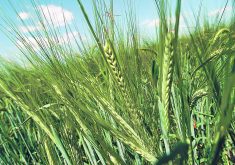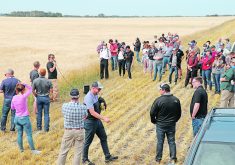Malt companies have list of tried and true growers
A specialty crop in Western Canada is usually described as a small acreage crop such as sunflowers and buckwheat, where the vast majority of production is contracted.
Malting barley may now fall into that category.
“We keep using the word that this is a ‘specialty’ crop. That keeps coming up more and more,” said Kevin Sich, grain department manager with Rahr Malting in Alix, Alta.
Rahr Malting contracts 100 percent of its malt barley supply from Alberta and Saskatchewan farmers. The company works with producers who have a proven record of growing high quality barley.
Read Also

Critical growing season is ahead for soybeans
What the weather turns out to be in the United States is going to have a significant impact on Canadian producers’ prices
“It becomes a relationship back and forth, between the maltster and the farmer, which has really evolved over the last five years,” Sich said.
“We have a lot of growers that are (at) 80 to 90 percent…. They’re getting malt eight or nine out of 10 years. The only years they’re not getting it is because of Mother Nature.”
Brian Otto, who farms near Warner, Alta., agreed the malting barley industry has changed significantly over the last several years.
The days of a farmer growing barley on speculation, hoping to get a price premium if it satisfied malting standards, are nearing an end.
Otto said maltsters have developed a list of preferred growers and form partnerships with them.
“The people who have been growing malt barley the last few years and meeting malt plant (standards), those are the people getting more contracts this year,” said Otto, who plans to seed 1,100 acres of malt barley this spring, up from 900 acres last year.
Otto said malt companies started becoming more selective before the end of the CWB monopoly, but the practice of buying from certain growers has accelerated in the last couple of years.
“This is all about relationships in the industry … establishing relationships with who buys your crop and maintaining those relationships by making sure you do a good job,” he said. “That’s the way the industry has been moving.”
Bob Cuthbert, senior marketing manager for barley with CWB, said maltsters used to rely on “a big pot” of malting barley in Western Canada. They would buy from growers who sent in a sample of the crop.
“They’ve had to (contract) because acres have been decreasing,” he said.
Prairie growers seeded more than 11 million acres of barley in the early 2000s. Statistics Canada is projecting 6.3 million acres this year.
Maltsters opted for production contracts to secure supply as barley acres declined, Cuthbert said.
“They have to show the farmer a price, up front, that’s competitive with other grains.”
Otto said he recently agreed to a contract price of $5.50 per bushel for part of his production in 2014.
That’s up about 25 percent from January, when malt barley contracts were around $4.40 per bu. in Alberta.
Sich said Rahr Malting has contracted 100 percent of malting barley supply for the last three years. He said maltsters use their relationship with growers to achieve a competitive advantage in the marketplace.
“We have a lot of brewers that are beside themselves,” Sich said.
“They can come and we can show them barley samples and trace it … right back to the farmer’s field. (We) show them all the chemicals that were sprayed. Give them land locations. Give them total traceability. It’s become a big marketing tool for our company.”

















